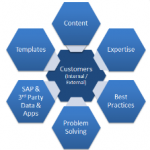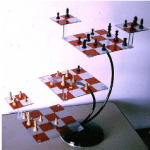The Importance of SAP Jam Implementation & Adoption Expertise
The rewards of using SAP Jam are awesome! Getting to the point where business and IT value is realized takes time, logic, dedication, and expertise. Successful SAP Jam implementations and adoption requires many considerations, some of which are often overlooked.
 It reminds me of the day when my family got a piano from my in-laws house for our son. While other children and friends would bang on the keys he wanted to play meaningful songs at an early age. There were adult friends and teachers who remembered playing a bit growing up (or knew a few songs) but could only offer a few ideas around how to play the piano beyond the basics.
It reminds me of the day when my family got a piano from my in-laws house for our son. While other children and friends would bang on the keys he wanted to play meaningful songs at an early age. There were adult friends and teachers who remembered playing a bit growing up (or knew a few songs) but could only offer a few ideas around how to play the piano beyond the basics.
Only when we got an expert piano teacher (on the second try) who had the style and skills which were complimentary to his interests did we see his enjoyment and piano playing skills soar forward.
 For my team and I working with leading customers and business units around the globe we see that no two SAP Jam implementations are alike. Like a snow flake each one has its own unique work patterns based on their customers, industry, lines of business and culture.
For my team and I working with leading customers and business units around the globe we see that no two SAP Jam implementations are alike. Like a snow flake each one has its own unique work patterns based on their customers, industry, lines of business and culture.
As a result we must be agile and dig deep on each engagement to address a wide range of skills, requirements, work experiences which range from HR, Learning, Onboarding …to Sales, Marketing, Services, Commerce and Customer Engagement …to Communications, IT, Procurement, Operations, Communities of Practice, and User Experiences …to working within a wide range of SAP and 3rd Party Apps and related Management Information System (MIS) environments …to the ability to write, provide visual consistency, and program management …as well as help turn complexity into …simplicity.
There are a number of best practice guidelines to consider:
 Consideration #1 – Getting Started!
Consideration #1 – Getting Started!
- Understanding the business requirements
- Enabling overall usability
- Translating the business process to SAP Jam
- Ensuring relevance by way of content / communications
- Utilizing dynamic widgets vs. static text and images
- Assessing Change Management
- Ensuring participation
Consideration #2 – ROI & Value
Pinpoint the SAP Jam Return On Investment (ROI) and business drivers important to your organization centered around “Time” “Money” and “People” scalability to ensure measurable (“quantifiable” and “qualifiable”) gains.
Consideration #3 – Differentiators
SAP Jam is a unique market leading solution. It seamlessly integrates social business capabilities into existing (& planned) business process whereas as other 3rd party platforms are focused on the tools. SAP has made SAP Jam an integral part of all SAP solutions addressing:
- All lines of business centric vs. CRM as the primary
- One SAP Jam vision vs. multiple roadmaps which have overlaps
- SAP’s proven 40-year history of business software, processes, and market leadership
- Collaborative ecosystem (Out of the Box – i.e. OpenText, Box, SharePoint, etc.)
- Application integration (i.e. OData, REST APIs) by utilizing the SAP Jam Developer Center
- Integrated platform as a foundational principal vs. a standalone which increases costs
- Internal & external SAP Jam group capabilities which easily set-up
- Structured collaboration to support problem solving, issue resolution, and decision making
- Screen and video capture
- Mobile App alignment with SAP Jam Page Designer provides out of the box mobile capabilities
Consideration #4 – Roles & Responsibilities
When addressing an SAP Jam initiative the executive sponsor, business owner(s), and project leader must consider 3 key roles including:
- Administrator(s) (or Power Users)
- Content Manager(s) (& Contributors)
- End Users
While one SAP Jam tactical action can be straight forward. Each action has a consequence on another aspect of the project or initiative.
 For those of us who watch (or remember) Star Trek and Spok’s 3D chess game, each move has an impact to another chess piece which may be on the board you are working on or another. It takes a lot of SAP Jam experience to address these moves which have important relationships to other business processes.
For those of us who watch (or remember) Star Trek and Spok’s 3D chess game, each move has an impact to another chess piece which may be on the board you are working on or another. It takes a lot of SAP Jam experience to address these moves which have important relationships to other business processes.
A successful SAP Jam implementation addresses 5 phases:
- Preparation
- Realization
- Verification
- Launch
- Post Go-Live
 It takes vision, leadership, teamwork, compelling business outcomes, and passion to build any successful community which meets either face-to-face or virtually. SAP Jam requires the same consideration to achieve successful implementations and adoption.
It takes vision, leadership, teamwork, compelling business outcomes, and passion to build any successful community which meets either face-to-face or virtually. SAP Jam requires the same consideration to achieve successful implementations and adoption.
Whether its learning how to play the piano or SAP Jam, it takes multi-dimensional expertise to ensure that all the “keys and pedals” are optimized.
SAP Jam has many self-evident, out of the box templates and capabilities that are excellent, but to gain the full advantage it takes the right skills, work experiences, and expertise to achieve the highest level of success.
— About the Author
 Richard D. Blumberg, President, World Sales Solutions, LLC (WSS) (www.WorldSalesSolutions.com) provides 25+ years of thought leadership on a variety of “View from the Top” strategies including: Enterprise Social Business, Go-to-Market Strategies, Business Development, Talent Development, and Community Building. He and his team are recognized SAP Jam global experts for implementations and adoption.
Richard D. Blumberg, President, World Sales Solutions, LLC (WSS) (www.WorldSalesSolutions.com) provides 25+ years of thought leadership on a variety of “View from the Top” strategies including: Enterprise Social Business, Go-to-Market Strategies, Business Development, Talent Development, and Community Building. He and his team are recognized SAP Jam global experts for implementations and adoption.
WSS is a SAP Service Partner for SAP Jam and long-time supporter of the SAP Community Network and the SAP Ecosystem.
Prior Blogs:
– View from the Top: Bill McDermott shares his success secrets at a #fireside chat!
– The Path to SAP Jam ROI Success
– SAP Jam Work Patterns: The Big $ or € &/or ¥ Game Changer for a New Product Launch!
– SAP Jam: The ROI Impacting Sales Productivity
– Split Second Selling with SAP Jam – 7 Use Cases!
– The Customer Go-to-Market Imperative – Transforming Silos to Social Business and Community Building
Originally posted on the SAP Community Network – full blog >>